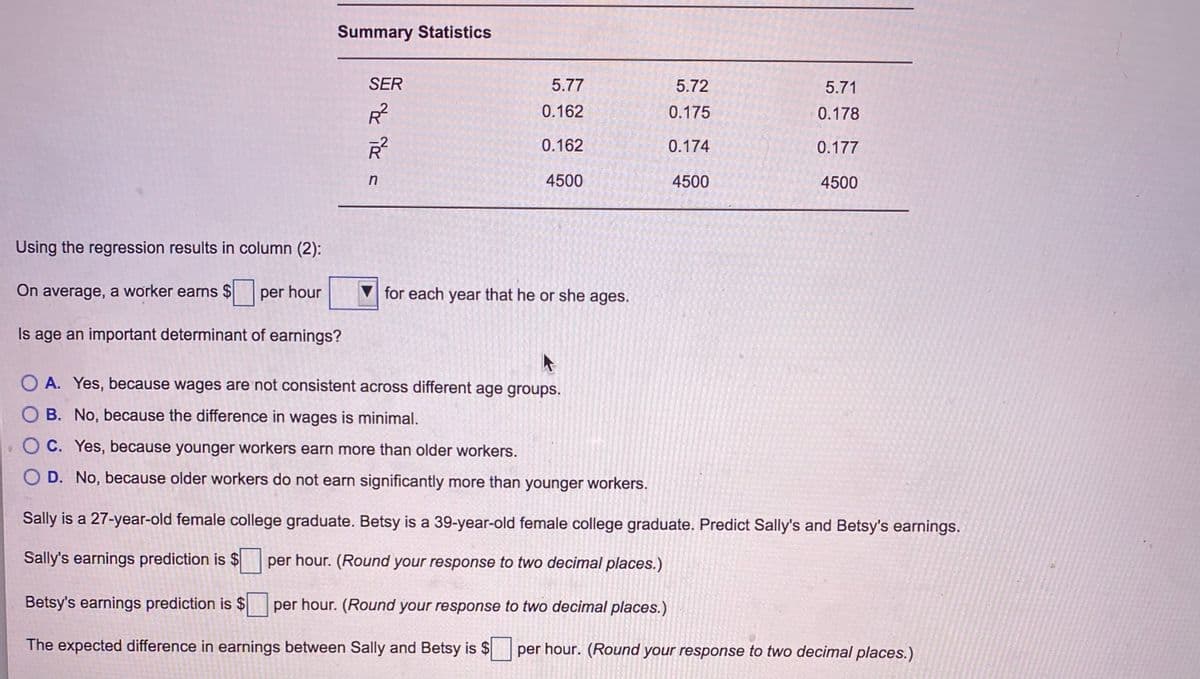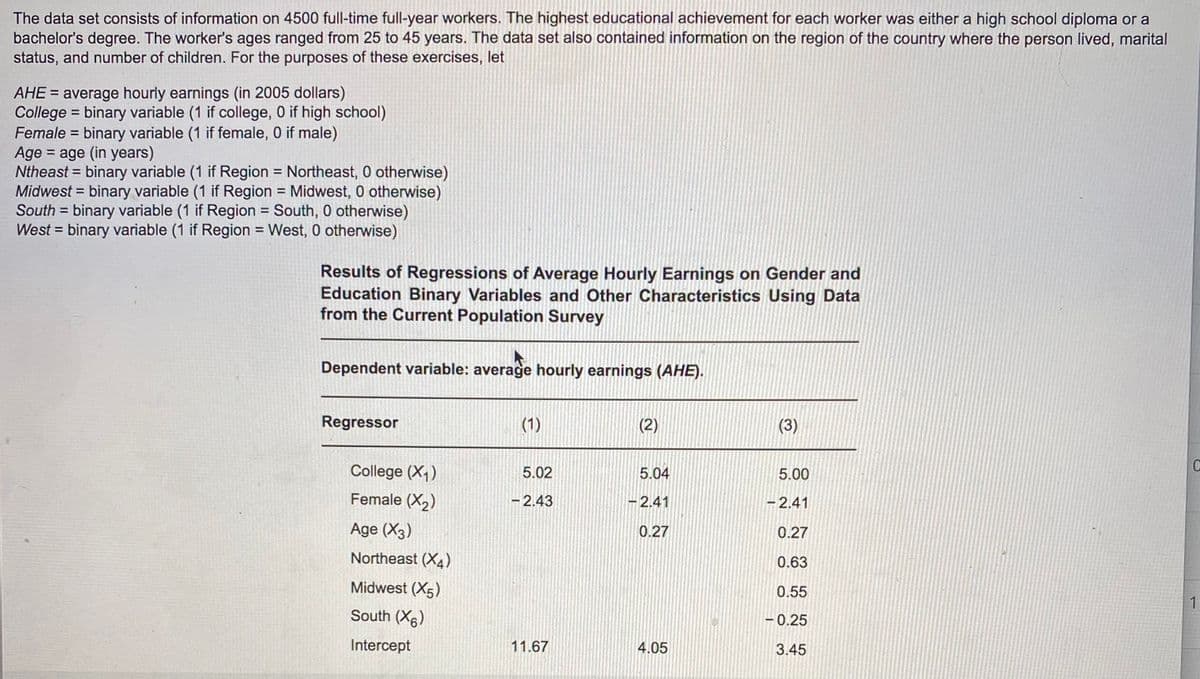The data set consists of information on 4500 full-time full-year workers. The highest educational achievement for each worker was either a high school diploma or a bachelor's degree. The worker's ages ranged from 25 to 45 years. The data set also contained information on the region of the country where the person lived, marital status, and number of children. For the purposes of these exercises, let AHE = average hourly earnings (in 2005 dollars) College = hinary variable (1 if college O if high school)
The data set consists of information on 4500 full-time full-year workers. The highest educational achievement for each worker was either a high school diploma or a bachelor's degree. The worker's ages ranged from 25 to 45 years. The data set also contained information on the region of the country where the person lived, marital status, and number of children. For the purposes of these exercises, let AHE = average hourly earnings (in 2005 dollars) College = hinary variable (1 if college O if high school)
Chapter9: Sequences, Probability And Counting Theory
Section9.5: Counting Principles
Problem 5SE: Answer the following questions. 5. What is the term for the arrangement that selects r objects from...
Related questions
Question

Transcribed Image Text:Summary Statistics
SER
5.77
5.72
5.71
0.162
0.175
0.178
0.162
0.174
0.177
4500
4500
4500
Using the regression results in column (2):
On average, a worker earns $
per hour
for each year that he or she ages.
Is age an important determinant of earnings?
O A. Yes, because wages are not consistent across different age groups.
O B. No, because the difference in wages is minimal.
O C. Yes, because younger workers earn more than older workers.
O D. No, because older workers do not earn significantly more than younger workers.
Sally is a 27-year-old female college graduate. Betsy is a 39-year-old female college graduate. Predict Sally's and Betsy's earnings.
Sally's earnings prediction is $
per hour. (Round your response to two decimal places.)
Betsy's earnings prediction is $per hour. (Round your response to two decimal places.)
The expected difference in earnings between Sally and Betsy is $
per hour. (Round your response to two decimal places.)

Transcribed Image Text:The data set consists of information on 4500 full-time full-year workers. The highest educational achievement for each worker was either a high school diploma or a
bachelor's degree. The worker's ages ranged from 25 to 45 years. The data set also contained information on the region of the country where the person lived, marital
status, and number of children. For the purposes of these exercises, let
AHE = average hourly earnings (in 2005 dollars)
College = binary variable (1 if college, 0 if high school)
Female = binary variable (1 if female, 0 if male)
Age = age (in years)
Ntheast = binary variable (1 if Region = Northeast, 0 otherwise)
Midwest = binary variable (1 if Region = Midwest, 0 otherwise)
South = binary variable (1 if Region = South, 0 otherwise)
West = binary variable (1 if Region = West, 0 otherwise)
%3D
%3D
%3D
%3D
%3D
%3D
%3D
Results of Regressions of Average Hourly Earnings on Gender and
Education Binary Variables and Other Characteristics Using Data
from the Current Population Survey
Dependent variable: average hourly earnings (AHE).
Regressor
(1)
(2)
(3)
C
College (X, )
Female (X2)
5.02
5.04
5.00
- 2.43
- 2.41
- 2.41
Age (X3)
0.27
0.27
Northeast (X4)
0.63
Midwest (X5)
0.55
1
South (X6)
- 0.25
Intercept
11.67
4.05
3.45
Expert Solution
This question has been solved!
Explore an expertly crafted, step-by-step solution for a thorough understanding of key concepts.
This is a popular solution!
Trending now
This is a popular solution!
Step by step
Solved in 4 steps

Recommended textbooks for you


Algebra: Structure And Method, Book 1
Algebra
ISBN:
9780395977224
Author:
Richard G. Brown, Mary P. Dolciani, Robert H. Sorgenfrey, William L. Cole
Publisher:
McDougal Littell

College Algebra (MindTap Course List)
Algebra
ISBN:
9781305652231
Author:
R. David Gustafson, Jeff Hughes
Publisher:
Cengage Learning


Algebra: Structure And Method, Book 1
Algebra
ISBN:
9780395977224
Author:
Richard G. Brown, Mary P. Dolciani, Robert H. Sorgenfrey, William L. Cole
Publisher:
McDougal Littell

College Algebra (MindTap Course List)
Algebra
ISBN:
9781305652231
Author:
R. David Gustafson, Jeff Hughes
Publisher:
Cengage Learning